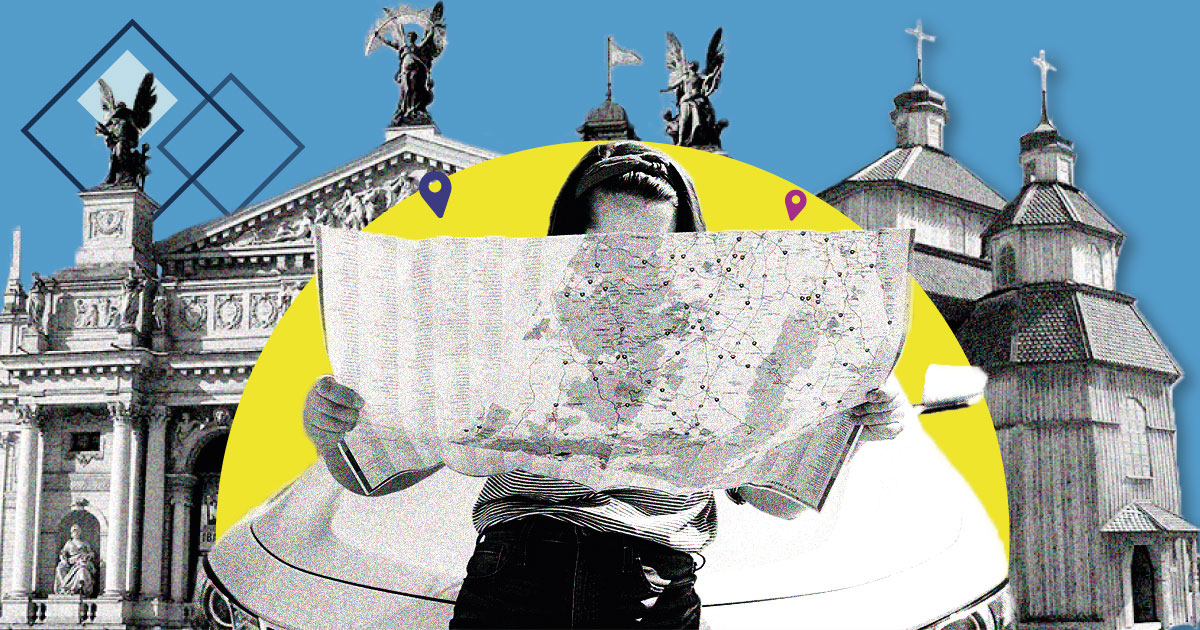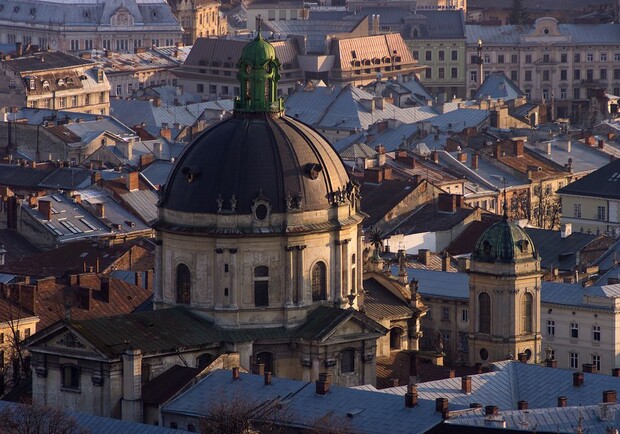From the Middle Ages to the present. From Khust to Sloviansk. We've traced Ukraine's history geographically. Let's time travel around Ukraine!


Photo: Rubryka
In a week, on August 24, Ukrainian Independence turns 30 years old. It was on August 24, 1991, that the Declaration of Independence was signed, which finally established the obvious fact: the Ukrainian SSR as a part of the Soviet Union ceased to exist to start a new page in its history as a free democratic state.
But Ukraine's independence is not just about the last 30 years. For many centuries Ukrainians fought for the sovereignty of their country. At different times, certain places were the cradles of Ukrainian freedom, so Rubryka decided to recollect where and how Ukrainian statehood was formed.
The long weekend is near. Save our ideas on where you can go on a trip to Ukraine to celebrate its anniversary and remember the history of Independence.
Medieval era


Lviv was founded in the first half of the 13th century, and from 1272, this city became the capital of the Galicia-Volyn principality. During the Middle Ages, the city was the center of cultural and economic development of Ukraine, despite the domination of other peoples in Ukraine.
During the Austro-Hungarian Empire, Lviv was the most developed city in the territory of Western Ukraine. It has always been characterized by the royal grandeur of the Galician princes: parks, estates, theaters, and streets still retain the atmosphere of ancient times, so this city is beautiful at any time of year. During the celebration of the 30th anniversary of Independence, residents and guests of the city are invited to attend many events, like holiday concerts, workshops, athletics, and parade.
According to the Hypatian Codex, Lutsk was founded in 1085, and later the city became the capital of a separate principality. The rise of Lutsk as the capital of Volyn as part of the Grand Duchy of Lithuania is closely connected with the reign of Lubart-Demetrius in the second half of the 14th century, after whose reign Lutsk remained the residence of Lithuanian-Rus princes and is still the capital of Volyn.
During this year's celebrations, the city has planned several holiday concerts, a festival of choral music, a book fair, and an exhibition of folk art masters.
Cossack era
On the territory of modern Zaporizhzhia, in the middle of the 16th century, the first Zaporizhzhia Sich was founded on the island of Khortytsia. And although it lasted only a few years, and after that, there were 7 different hosts in Dnipropetrovsk, Zaporizhzhia, and Kherson regions, it was the philosophy and principles of the first Sich by Dmytro Vyshnevetskyi that laid the trend of Ukrainian history for two centuries.
August 24 celebrations on Khortytsia Island will include a historic reconstruction of the Cossack council, holiday concerts, and a military parade.
The decree on the founding of the town of Chyhyryn in the Cherkasy region was issued in 1589 by the Polish king, and at the beginning of the 16th century, the town was built by a Cossack winterer with a small fortress. From 1648 to 1676 Chyhyryn was the residence of famous Ukrainian hetmans, like Bohdan Khmelnytskyi, Ivan Vyhovskyi, Yurii Khmelnytskyi, Pavlo Teteria, Petro Doroshenko, and the capital of the Hetman Ukrainian state.
During Khmelnytskyi's time, Chyhyryn was one of the largest cities in Ukraine. More than 50,000 people lived here, state and military administrations were located here, and the hetman's residence and palace stood. Under the walls of this city for 5 years, there was a struggle for Cossack lands between the Ottoman and Russian empires, which ended with the destruction of the city in 1681.
Today the town is a small village of urban importance, where the Cossack spirit is still preserved, and the residence of Bohdan Khmelnytskyi and the Archaeological Museum are among the interesting places to visit.
The first record of Baturyn dates back to 1625. More than three centuries ago, it was the capital of the Left Bank of Ukraine, a witness to many political intrigues, military victories, and tragedies. Back in 1669, Hetman Demian Mnohohrishnyi chose Baturyn as his residence, then Ivan Samoilovych ruled Ukraine; from 1672 to 1708, it was Ivan Mazepa, and in 1750-1764, the last Hetman of Ukraine, Kyrylo Rozumovskyi. That is why Baturyn is called the hetman's capital.
During the hetmanship of Mazepa, who attached great importance to Ukrainian culture, the city reached its greatness. Many brick buildings with beautiful European architecture appeared in Baturyn, and the population was 20,000. In 1708, the Russian army annihilated Baturyn and its residents; this happened after the famous Battle of Poltava. Only in the 1750s did Hetman Kyrylo Rozumovskyi, having moved the capital here, began to rebuild the city.
After the elimination of the Hetmanate in 1764, Baturyn declined until the beginning of Ukraine's independence, when the National Historical and Cultural Reserve "Hetman's Capital" was formed here in 1994, which included 39 objects of unique historical, archeological, and natural landmarks, together with the palace of Hetman Razumovskyi.
Hlukhiv is one of the oldest cities in Ukraine, founded in 992. It flourished in the 18th century during the so-called Hlukhiv period in the Hetmanate's history. From 1709 to 1764, Hlukhiv was the residence of hetmans after the destruction of Baturyn.
After the elimination of the hetman state in 1764, the Little Russia province with the administrative center in Hlukhiv was created in 1765 from a part of the Left Bank of Ukraine.
Since the Cossack era, the fortress with the brick Kyiv Gate, as well as Radnyi Maidan, St. Nicholas Church, and Ascension Church have partially survived. After walking through the narrow streets, you can reach the triumphal arc. This architectural monument marks the old city limits and is located at the top of the defensive wall of the Cossack times.
Early 20th century
After the founding of the Ukrainian SSR, Kharkiv, not Kyiv, became the capital of the formed republic and retained this status until 1934. Kharkiv is called the "First Capital of Soviet Ukraine," and in 16 years, Kharkiv has actually become the cultural center of the country. However, the city suffered a lot during this short period; in the literature, Kharkiv was repeatedly called the "capital of the Holodomor" and the "Executed Renaissance."
During the pre-Soviet period, Kharkiv was always the largest city in the Left Bank of Ukraine, the first university on the Left Bank was founded here in 1805, Hryhorii Kvitka-Osnovianenko lived and worked here, as well as other well-known figures in literature (Pavlo Tychyna, Volodymyr Sosiura, Vasyl Ellan-Blakytnyi, Ostap Vyshnia, Ivan Bahrianyi, and others).
In honor of the 30th anniversary of Independence Day, the city will lay flowers to the Independence Monument; a festive program "Colors of Ukraine" in Gorkyi Park, and a choreographic and theatrical performance on Freedom Square will take place.
This cozy town in Zakarpattia was founded in 1090 as the center of the salt road from Solotvyno to the Danube cities, and since ancient times there was Khust Castle, an impregnable fortress, which was a strategic fortification of Transcarpathia for many centuries. Even the Turks tried to bypass it during their raids on Ukraine.
The castle burned down by lightning in 1766, after which the town lost its significance. In the 20th century, before the beginning of the Second World War in 1939, an independent state was proclaimed on the territory of Transcarpathia, Carpathian Ukraine, with its capital in Khust.
The Carpathians were independent for several months, after which Hungary regained power in the territory. Because of this, Khust is sometimes jokingly called the one-day capital. Although this period didn't last long, it vividly reflects the mood of the Ukrainians of that time in the struggle for their independence.
The present and places of power
The first record of the settlement dates back to the first half of the 17th century, the settlement was officially founded in 1676. The city has always been associated with the extraction of salt, a deposit of which is located near the Torun lakes.
Sloviansk is inextricably linked to the recent history of Ukraine. During the seizure of Donbas by terrorist groups from Russia in 2014, Sloviansk was the first city to be seized, but the locals showed great resilience in their beliefs about their homeland.
Together with the Ukrainian military, they did everything possible to raise the Ukrainian flag over the city of majors. The city was liberated for the next 3 months and never returned to Russian control. Today Sloviansk is a leading city of Donbas, a cultural and economic center.
The first mention of the city dates back to the end of the 11th century, and this city was famous for its cliffs, the Kaniv Mountains, where one of the most famous Ukrainians, Taras Shevchenko, found eternal rest. Therefore, since 1861, this city has had a new history.
In Kaniv, there are many places connected with the poet's life and death; his beloved lived here. The cathedral where the poet was buried is still preserved; the way, which was overcome to his homeland, is considered sacred, and after Shevchenko's funeral, Chernecha mountain was immediately renamed Tarasova.
Today Kaniv is the cultural center of Ukraine. There's the Shevchenko Historical and Cultural Reserve, which was the first in Ukraine to gain national status. And yet, it's truly the most picturesque corner of the Dnieper, which is forever etched in the memory of all who come here.
Our Capital prevails over all centuries. Throughout the period of Ukrainian statehood, Kyiv held all the cities together and desperately accepted all the challenges of history, both during the existence of Kyivan Rus and during the Tatar-Mongol invasion; Kyiv was one of the main administrative centers of the Grand Duchy of Lithuania and the largest Cossack regiment, became a stronghold of the struggle for independence during the collapse of the Russian Empire. Kyiv became the capital of the Ukrainian SSR, for which the entire country fought in 1943.
After gaining Independence, the challenges for Kyiv were not over; the Revolution on Granite, the Orange Revolution and the Revolution of Dignity are still echoing in the hearts of modern Ukrainians. That is why our capital remains a real fighter for freedom for centuries.
This year, the largest celebrations of Independence Day are planned in Kyiv: festivals, gala concerts, bike rides, sports championships, mass swimming, cultural and educational marathon, exhibitions, and interactive events, a total of 67 diverse events.
“Рубрика” зібрала для вас статті, які, як, власне, і березень, кажуть: навіть у найскладніші часи… Читати більше
Першим кроком до того, щоб розпоряджатись своїми коштами грамотно, є планування бюджету. Як розрахувати кошти… Читати більше
Власним досвідом та практичними порадами з “Рубрикою” поділилася корекційна педагогиня, психотерапевтка, мама дітей з розладами… Читати більше
Вже під час війни Україна використовує штучний інтелект (ШІ) як потужний інструмент для відбудови та… Читати більше
У Житомирській обласній філармонії ім. С. Ріхтера пів року працює студія PНIL-ART. Тут професійні артисти… Читати більше
In our conversation, Dmytro Syrykh discusses the work of Ukraine's Energy Efficiency Fund amid the… Читати більше
Цей сайт використовує Cookies.